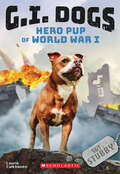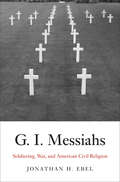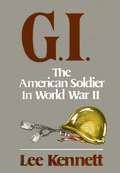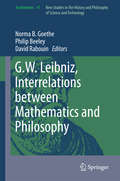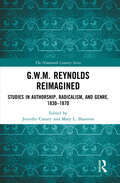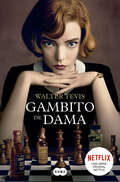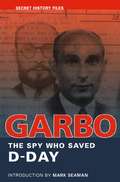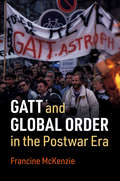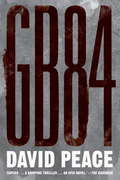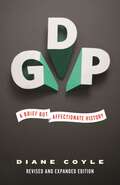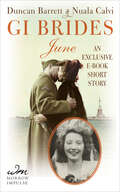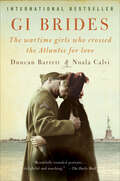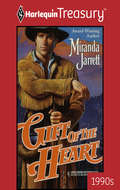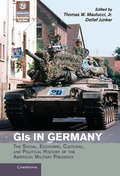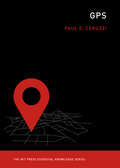- Table View
- List View
G.I. Dogs: Sergeant Stubby, Hero Pup of World War I (G.I. Dogs #2)
by Laurie CalkhovenGo behind enemy lines through the eyes of famous four-legged heroes in history's biggest conflicts. In G.I. Dogs #2, you'll meet Sergeant Stubby, the most decorated canine soldier of World War I!Meet Stubby: a stray pup who was taken in by a group of American soldiers-in-training and soon found himself whisked off to the frontlines of World War I as the official mascot of the 102nd Infantry Regiment! Stubby served bravely by his soldiers' sides for 18 months and became a hero when he saved his regiment from a surprise gas attack, and again when he singlehandedly caught an enemy German soldier in No Man's Land.Join Stubby on his incredible journey from puppy to soldier to high-ranking sergeant as he narrates his story of heroism. This "dog's-eye view" takes readers into the heart of the action of WWI and will leave you cheering for Stubby and his human companions as they overcome countless obstacles and prove time and again why a dog really is man's best friend.
G.I. Messiahs
by Jonathan H. EbelJonathan Ebel has long been interested in how religion helps individuals and communities render meaningful the traumatic experiences of violence and war. In this new work, he examines cases from the Great War to the present day and argues that our notions of what it means to be an American soldier are not just strongly religious, but strongly Christian. Drawing on a vast array of sources, he further reveals the effects of soldier veneration on the men and women so often cast as heroes. Imagined as the embodiments of American ideals, described as redeemers of the nation, adored as the ones willing to suffer and die that we, the nation, may live-soldiers have often lived in subtle but significant tension with civil religious expectations of them. With chapters on prominent soldiers past and present, Ebel recovers and re-narrates the stories of the common American men and women that live and die at both the center and edges of public consciousness. "
G.I.: The American Soldier in World War II
by Lee KennettLee Kennett provides a vivid portrait of the American soldier, or G.I., in World War II, from his registration in the draft, training in boot camp, combat in Europe and the Pacific, and to his final role as conqueror and occupier. It is all here: the "greetings" from Uncle Sam; endless lines in induction centers across the country; the unfamiliar and demanding world of the training camp, with its concomitant jokes, pranks, traditions, and taboos; and the comparative largess with which the Army was outfitted and supplied. Here we witness the G.I. facing combat: the courage, the heroism, the fear, and perhaps above all, the camaraderie--the bonds of those who survived the tragic sense of loss when a comrade died. Finally, when the war was over, the G.I.'s frequently experienced clumsy, hilarious, and explosive interactions with their civilian allies and with the former enemies whose countries they now occupied.
G.W. Leibniz, Interrelations between Mathematics and Philosophy
by Norma B. Goethe Philip Beeley David RabouinUp to now there have been scarcely any publications on Leibniz dedicated to investigating the interrelations between philosophy and mathematics in his thought. In part this is due to the previously restricted textual basis of editions such as those produced by Gerhardt. Through recent volumes of the scientific letters and mathematical papers series of the Academy Edition scholars have obtained a much richer textual basis on which to conduct their studies - material which allows readers to see interconnections between his philosophical and mathematical ideas which have not previously been manifested. The present book draws extensively from this recently published material. The contributors are among the best in their fields. Their commissioned papers cover thematically salient aspects of the various ways in which philosophy and mathematics informed each other in Leibniz's thought.
G.W.M. Reynolds Reimagined: Studies in Authorship, Radicalism, and Genre, 1830-1870 (The Nineteenth Century Series)
by Mary L. Shannon Jennifer ConaryThis essay collection proposes that G.W.M. Reynolds’s contribution to Victorian print culture reveals the interrelations between authorship, genre, and radicalism in popular print culture of the nineteenth century. As a best-selling author of popular fiction marketed to the lower classes, and a passionate champion of radical politics and "the industrious classes," Reynolds and his work demonstrate the relevance of Victorian Studies to topics of pressing contemporary concern including populism, working-class fiction, the concept of ‘originality’, and the collective scholarly endeavour to ‘widen’ and ‘undiscipline’ Victorian Studies. Bringing together well-known and newly-emerging scholars from across different disciplinary perspectives, the volume explores the importance of Reynolds Studies to scholarship on the nineteenth-century. This book will appeal to students and scholars of the nineteenth-century press, popular culture, and of authorship, as well as to Victorian Studies scholars interested in the translation of Victorian texts into new and indigenous markets.
GAMBITO DE DAMA
by Walter TevisO romance que deu origem à série mais vista da história de Netflix A série da moda. O livro do momento. A personagem da sua vida. Com um ritmo acelerado e escrito com elegância, Gambito de Dama é uma história fascinante disfarçada de romance de xadrez - um romance que não vai poder deixar de ler e com uma conclusão tão elegante e satisfatória quanto um mate em quatro. Quando a mãe de Beth Harmon, de oito anos, morre num acidente de viação, a menina é enviada para orfanato em Mount Sterling, Kentucky. Simples, taciturna e tímida, ao que tudo indica, Beth não se destaca… até jogar a sua primeira partida de xadrez. Os seus sentidos ficam mais aguçados, o pensamento mais claro e, pela primeira vez na sua vida, ela sente-se totalmente no controlo. Sem dinheiro nenhum, Beth está desesperada para aprender mais sobre esse jogo que se tornou a sua vida - rouba uma revista de xadrez, dinheiro suficiente para entrar num torneio e também alguns dos tranquilizantes da mãe adoptiva, nos quais está viciada. Aos treze anos, vence um torneio de xadrez; aos dezasseis, compete no US Open Championship; aos dezoito, é campeã dos Estados Unidos - e a Rússia espera por ela… Mas, à medida que Beth aprimora as suas habilidades no circuito profissional, as apostas ficam mais altas, o seu isolamento fica mais assustador, as suas incontroláveis adicções e a ideia de escapar tornam-se ainda mais tentadoras. Os elogios da crítica: «Apaixonante. Uma leitura viciante.»Financial Times «Hipnótico.»Newsweek «Excepcional.»Time Out «Convincente. Uma obsessão magnífica.»Los Angeles Times «Beth Harmon é uma criação inesquecível - e Gambito de Dama é a obra mais consumada e comovente de Walter Tevis.»Jonathan Lethem «Gambito de Dama é puro entretenimento. É um livro que releio frequentemente... pelo puro prazer e pela habilidade do autor.»Michael Ondaatje
GARBO: The Spy Who Saved D-Day
by Mark Seaman National ArchivesJuan Pujol, a young Spanish antifascist, became agent GARBO, a master of deception and intrigue. His story contains all the hallmarks of classic spy adventure—enciphered messages, secret inks, items concealed in cakes—culminating in one of the greatest strategic deceptions in history. Through a ring of invented subagents, GARBO and his MI5 controllers succeeded in convincing the Germans that the DDay landings were only a diversionary tactic, thus safeguarding the Allied landings and hastening the end of the war in Europe. Secret History Files is an exciting series from The National Archives that puts covert history in readers’ hands. Dossiers previously classified as "Top Secret" are now available, with an explanatory introduction and background analysis by expert historians. Publisher’s Note: This publication brings you in full the ’Summary of the Garbo Case 1941—1945’ by Tomás Harris. All document references are to the original files, which may be consulted under supervision at the National Archives, Kew. Our intention is to reproduce the material as faithfully as possible without compromising the integrity of the original. This means that the occasional inconsistency or typing error survives from Harris’s text. The symbol […] is used where material from the original document has been retained under section 3(4) of the Public Records Act 1958.
GATT and Global Order in the Postwar Era
by Francine McKenzieAfter the Second World War, the General Agreement on Tariffs and Trade (GATT) promoted trade liberalization to help make the world prosperous and peaceful. Francine McKenzie uses case studies of the Cold War, the creation of the EEC and other regional trade agreements, development, and agriculture, to show that trade is a primary goal of foreign policy, a dominant (and divisive) aspect of international relations, and a vital component of global order. She unpacks the many ways in which trade was politicised, and the layers of meaning associated with trade; trade policies, as well as disputes about trade, communicated ideas, hopes and fears that were linked to larger questions of identity, sovereignty, and status. This study reveals how the economic and political dimensions of foreign policy and international engagement intersected, showing that trade was not only instrumentalised in the service of particular policies or relations but that it was also an essential aspect of international relations.
GB84
by David PeaceNever before published in the U.S., GB84 will be launched in 2014 alongside two other novels by David Peace: The Damned Utd and Red or DeadIn taut and gripping prose that often feels like the relentless text of a surveillance report, GB84 tells the story of the British coal miner's strike of 1984--including the actual bombings, riots and protests that brought the country to the brink of civil war.Called by its author "fiction based on fact," the book depicts a real-life 1984 more violently dystopian than even Orwell imagined. Slowly starving strikers find themselves pitted against a prime minister--Margaret Thatcher--determined to crush them . . . a police force willing to use infiltration and violence to achieve her will . . . and equally hungry scabs who need a job . . .Mixing real events and characters with the voices of the increasingly desperate strikers, the book becomes a stirring saga of courage against overwhelmingly sinister forces, and paints a searing and haunting portrait of events that changed the course of British history.From the Trade Paperback edition.
GCSE Test Prep Flash Cards: Modern World History (Exambusters GCSE Workbook #8)
by Ace Inc.<P><P><i>Advisory: Bookshare has learned that this book offers only partial accessibility. We have kept it in the collection because it is useful for some of our members. Benetech is actively working on projects to improve accessibility issues such as these.</i><P><P> 600 questions and answers. Essential names, dates, and summaries of key historical events. <P><P>Topics: Ancient Egypt and Asia, Ancient Greece, Ancient Rome, Early Asia, Evolution of Religion, Middle Ages, Early Modern Times, Colonial Empires, Rights and Revolutions, Nationalism, Imperialism and World War I, Between the World Wars, World War II, The United Nations, The Cold War, 19th-20th Century Japan, Contemporary Age, Contemporary Africa, Contemporary Latin America, Contemporary Eurasia, Into The New Millennium <P> Exambusters GCSE Prep Workbooks provide comprehensive GCSE review--one fact at a time--to prepare students to take practice GCSE tests. Each GCSE study guide focuses on fundamental concepts and definitions--a basic overview to begin studying for the GCSE exam. Up to 600 questions and answers, each volume in the GCSE series is a quick and easy, focused read. Reviewing GCSE flash cards is the first step toward more confident GCSE preparation and ultimately, higher GCSE exam scores!
GDP: A Brief but Affectionate History - Revised and expanded Edition
by Diane CoyleHow GDP came to rule our lives—and why it needs to changeWhy did the size of the U.S. economy increase by 3 percent on one day in mid-2013—or Ghana's balloon by 60 percent overnight in 2010? Why did the U.K. financial industry show its fastest expansion ever at the end of 2008—just as the world’s financial system went into meltdown? And why was Greece’s chief statistician charged with treason in 2013 for apparently doing nothing more than trying to accurately report the size of his country’s economy? The answers to all these questions lie in the way we define and measure national economies around the world: Gross Domestic Product. This entertaining and informative book tells the story of GDP, making sense of a statistic that appears constantly in the news, business, and politics, and that seems to rule our lives—but that hardly anyone actually understands.Diane Coyle traces the history of this artificial, abstract, complex, but exceedingly important statistic from its eighteenth- and nineteenth-century precursors through its invention in the 1940s and its postwar golden age, and then through the Great Crash up to today. The reader learns why this standard measure of the size of a country’s economy was invented, how it has changed over the decades, and what its strengths and weaknesses are. The book explains why even small changes in GDP can decide elections, influence major political decisions, and determine whether countries can keep borrowing or be thrown into recession. The book ends by making the case that GDP was a good measure for the twentieth century but is increasingly inappropriate for a twenty-first-century economy driven by innovation, services, and intangible goods.
GDR Literature in German Curricula and Textbooks: Exploring the Legacy of GDR Authors, 1985-2015 (Palgrave Studies in Educational Media)
by Elizabeth Priester StedingThis book analyzes the changing portrayal of GDR literature in German Gymnasium textbooks 1985-2015. Addressing the need for textbook research to broaden its focus from GDR history to GDR literature, the author presents case studies of well-known GDR authors (Bertolt Brecht, Johannes R. Becher, Anna Seghers, Wolf Biermann, and Christa Wolf), each examining a particular aspect of the societal discourse about GDR literature and the tension between (literary) text and (historical) context. Taken together, the case studies reveal the frequently underestimated power of ideology in literature textbooks. They also show how attempts to package these authors into simplified categories ultimately reveal the profound complexities of the GDR literary legacy. By examining the clear tension between literature and politics in textbooks and curricula, the author demonstrates how ideological messages are transmitted in all textbooks, as well as the importance of attending to overt and covert ideology.
GEBORGTE TRÄUME: SERIE DER FAMILIE PENNINGTON (SCHOTTISCHEN TRAUM-TRILOGIE)
by Jan Coffey May McGoldrickSERIE DER FAMILIE PENNINGTON DER VORSCHLAG Millicent Wentworth will das Böse, das ihr toter Ehemann angerichtet hat, ungeschehen machen und muss einen Weg finden, ihr Anwesen zu retten und die unschuldigen Menschen zu befreien, die er versklavt hat. Ihre einzige Hoffnung ist eine Heirat - nur dem Namen nach - mit dem berüchtigten Witwer, dem Earl of Aytoun. DER BRÄUTIGAM Am Boden zerstört von dem tragischen Unfall, bei dem seine Frau ums Leben kam und er schwer verwundet wurde, wird Lyon Pennington, vierter Earl of Aytoun, von den Anschuldigungen gequält, die ihm die Schuld an der Katastrophe geben. Voller Verzweiflung lässt er sich von seiner Mutter in eine Vernunftehe locken - einer gutherzigen Frau zuliebe, die am Rande des finanziellen Ruins steht. DIE SEHNSUCHT Unter Millicents sanftem Blick beginnt Lyon wieder zu Kräften zu kommen, und sein verwundetes Herz beginnt zu heilen. Und schon bald entdeckt Millicent, dass Lyon unter seinem widerspenstigen Bart und seinem grimmigen Auftreten der attraktivste und fürsorglichste Mann sein könnte, dem sie je begegnet ist. Zum ersten Mal in ihrem Leben merkt sie, dass sie lebt - mit einem schwelenden Verlangen nach dem einen Mann, den sie für immer lieben wird... Holt Medallion Winner for Best Historical Romance Romantic Times Award Winner for Best British-Set Historical Romance
GED Test Prep Flash Cards: Social Studies 2 - World History (Exambusters GED Workbook #13 of 13)
by Ace Inc.<P><P><i>Advisory: Bookshare has learned that this book offers only partial accessibility. We have kept it in the collection because it is useful for some of our members. Benetech is actively working on projects to improve accessibility issues such as these.</i><P><P> 600 questions. Topics: Beginning of Civilization, Middle Ages, Nationalism, Imperialism, The Cold War, and more. <P><P>EXAMBUSTERS GED Prep Workbooks provide comprehensive, fundamental GED review--one fact at a time--to prepare students to take practice GED tests. Each GED study guide focuses on one specific subject area covered on the GED exam. From 300 to 600 questions and answers, each volume in the GED series is a quick and easy, focused read. Reviewing GED flash cards is the first step toward more confident GED preparation and ultimately, higher GED exam scores!
GED Test Prep Flash Cards: Social Studies I - American History (Exambusters GED Workbook #12 of 13)
by Ace Inc.<P><P><i>Advisory: Bookshare has learned that this book offers only partial accessibility. We have kept it in the collection because it is useful for some of our members. Benetech is actively working on projects to improve accessibility issues such as these.</i><P><P> 600 questions (ILLUSTRATED). Topics: Colonial Era, Revolutionary Era, Age of Expansion, Civil War, Reconstruction, The 1920s, The Depression, and more. <P><P>EXAMBUSTERS GED Prep Workbooks provide comprehensive, fundamental GED review--one fact at a time--to prepare students to take practice GED tests. Each GED study guide focuses on one specific subject area covered on the GED exam. From 300 to 600 questions and answers, each volume in the GED series is a quick and easy, focused read. Reviewing GED flash cards is the first step toward more confident GED preparation and ultimately, higher GED exam scores!
GENETICS
by Samuel Carbaugh Carla MooneyWhy do children resemble their parents and siblings? Introducing young readers to the fascinating world of genetics, this educational resource presents the main concepts of the science, including what a chromosome does, how DNA is structured, and how genetic inheritance works. Students learn about new discoveries in the field of genetics and how those discoveries have helped to cure or even prevent certain diseases, as well as examine controversial issues in genetics such as genetically modified foods and stem cell research. Combining inquiry-based, age-appropriate activities with biology, Genetics: Breaking the Code of Your DNA features graphic novel illustrations, fascinating sidebars, and a glossary of important vocabulary to illuminate the complex world of genetics and bring it to life. Projects include building 3D DNA double helix models, extracting DNA, using a Punnet Square to predict an offspring's probability of inheritance, and evaluating the benefits and risks of genetically engineering a new species. Additional materials include a list of current reference works, websites, and Internet resources. Genetics meets common core state standards in language arts for reading informational text and literary nonfiction and is aligned with Next Generation Science Standards. Guided Reading Levels and Lexile measurements indicate grade level and text complexity.
GI Brides: An Exclusive E-book Short Story (GI Brides #1)
by Nuala Calvi Duncan BarrettShe left everything behind to follow her heart … The enthralling true story of a British war bride after World War II.June Baker saw the American soldier walking toward her. In the gray of wartime England, he looked out of place—as if a blond movie star had just dropped out of the sky. They had a whirlwind courtship, and June fell in love with and married Borgy, the handsome GI from St. Charles, Missouri. She eagerly anticipated her new life in America. But when the war ended, June was horrified to learn they'd be moving to Germany—land of the enemy—instead. And just like that, June's unexpected journey began …June's story is a bonus installment of the international bestseller GI Brides.
GI Brides: The Wartime Girls Who Crossed The Atlantic For Love (GI Brides #1)
by Nuala Calvi Duncan BarrettThis “delightful and touching” international bestseller tells the true stories of four British women who married American soldiers after WWII (Daily Mail, UK).American soldiers stationed in the UK came away winning more than just a war, they also won the hearts of young women across Britain. At the end of World War II, more than 70,000 GI brides followed the men they’d married—men they barely knew—to begin a new life in the United States. This volume vividly recounts the stories of four such women as they made America their home.In GI Brides, readers will meet Sylvia Bradley, a loyal, bright-eyed optimist; Rae Brewer, a resourceful, quick-witted tomboy; Margaret Boyle, an English beauty who faced down every challenge; and Gwendolyn Rowe, a brave woman ahead of her time. Though all made the bold choice to leave family and the world they knew, the journey each experienced was unique—ranging from romantic to heartbreaking.
GIFT OF THE HEART (Sparhawk #4)
by Miranda JarrettRACHEL SPARHAWK LINDSEY CAME FROM A LONG LINE OF SURVIVORSShe would not fail her heritage. But the snows were deep and the nights lonely-until Jamie Ryder arrived, bringing strength and joy into the hidden places of her heart....The warmth of hearth and home had long been denied Jamie Ryder. Now Rachel Lindsey offered him refuge from the storms without-and the war within. But he knew this dream of love and family could not withstand the nightmare of his past....
GIMP: The Story Behind the Star of Murderball
by Tim Swanson Mark ZupanCollege soccer star Mark Zupan had been out drinking one night and had passed out in the back of his best friend's pickup truck when his friend got in the driver's seat, decided to take the truck for a spin, and accidentally crashed it. Thrown into a canal and stuck in frigid water for fourteen hours, Mark was finally rescued and learned soon after that he'd broken his neck. He'd most likely be a quadriplegic and spend the rest of his life in a wheelchair, doctors told him. At first Mark's only goal was to walk again. When that proved impossible, he fell into the depths of anger and despair, retreating from the world and the people closest to him. But love, friendship, and a new sport, quad rugby (a.k.a. "murderball"), helped Mark create a new existence that's truly exceptional.Gimp, the no-holds-barred memoir of a Paralympic athlete and the star of the Academy Award–nominated documentary Murderball, is an inspiring, defiant, and revealing celebration of spirit and will that confounds readers' prejudices by offering proof that a guy in a chair can still do amazing things: have sex with his girlfriend, party with his friends . . . even crowd-surf at Pearl Jam shows.
GIs in Germany: The Social, Economic, Cultural, and Political History of the American Military Presence (Publications of the German Historical Institute)
by Detlef Junker Thomas W. Maulucci JrThe fifteen essays in this volume offer a comprehensive look at the role of American military forces in Germany. The American military forces in the Federal Republic of Germany after WWII played an important role not just in the NATO military alliance but also in German-American relations as a whole. Around twenty-two-million US servicemen and their dependants have been stationed in Germany since WWII, and their presence has contributed to one of the few successful American attempts at democratic nation building in the twentieth century. In the social and cultural realm the GIs helped to Americanize Germany, and their own German experiences influenced the US civil rights movement and soldier radicalism. The US military presence also served as a bellwether for overall relations between the two countries.
GNSS Atmospheric Seismology: Theory, Observations and Modeling
by Shuanggen Jin R. Jin X. LiuGNSS can detect the seismic atmospheric-ionospheric variations, which can be used to investigate the seismo-atmospheric disturbance characteristics and provide insights on the earthquake. This book presents the theory, methods, results, and modeling of GNSS atmospheric seismology. Sesimo-tropospheric anomalies, Pre-/Co-/Post-seismic ionospheric disturbances, epicenter estimation, tsunami and volcano ionospheric disturbances, and volcanic plumes detection with GNSS will be presented and discussed per chapter in the book.
GOVT4
by Beth Henschen Edward I. SidlowCreated through a student-tested, faculty-approved review process with input from more than 200 students and faculty, GOVT4 is an engaging and accessible solution to accommodate the diverse lifestyles of today's learners. Focusing on the current and historical conflicts and controversies that define America as a nation, GOVT4 is a streamlined and extremely current text for the American Government course. Its motivating debate theme and appealing modern format speak directly to today's learners.
GPS (The MIT Press Essential Knowledge series)
by Paul E. CeruzziA concise history of GPS, from its military origins to its commercial applications and ubiquity in everyday life.GPS is ubiquitous in everyday life. GPS mapping is standard equipment in many new cars and geolocation services are embedded in smart phones. GPS makes Uber and Lyft possible; driverless cars won't be able to drive without it. In this volume in the MIT Press Essential Knowledge series, Paul Ceruzzi offers a concise history of GPS, explaining how a once-obscure space technology became an invisible piece of our infrastructure, as essential to modern life as electric power or clean water. GPS relays precise time and positioning information from orbiting satellites to receivers on the ground, at sea, and in the air. It operates worldwide, and its basic signals are free, although private companies can commodify the data provided. Ceruzzi recounts the origins of GPS and its predecessor technologies, including early aircraft navigation systems and satellites. He describes the invention of GPS as a space technology in the post-Apollo, pre-Space Shuttle years and its first military and commercial uses. Ceruzzi explains how the convergence of three major technological developments—the microprocessor, the Internet, and cellular telephony—enabled the development and application of GPS technology. Recognizing the importance of satellite positioning systems in a shifting geopolitical landscape—and perhaps doubting U.S. assurances of perpetual GPS availability—other countries are now building or have already developed their own systems, and Ceruzzi reports on these efforts in the European Union, Russia, India, China, and Japan.
GPs, Politics and Medical Professional Protest in Britain, 1880–1948 (Routledge Studies in Modern British History)
by Chris LockeThis book charts the journey of British General Practitioners (GPs) towards professional self-realisation through the development of a political consciousness manifested in a series of bruising encounters with government. GPs are an essential part of the social fabric of modern Britain but as a group have always felt undervalued, clashing with successive governments over the terms on which they offered their services to the public. Explaining the background to these disputes and the motives of GPs from a sociological perspective, this research casts new light on some defining moments in the creation of the modern British state, from National Health Insurance to the National Health Service, and the history of the British medical profession. It examines these events from the point of view of the professionals intimately involved in and affected by them, using both established sources, like Ministry of Health records, an in-depth analysis of rarely studied records of professional bodies, and previously unresearched archive material. The result is a fascinating account of conflict and cooperation, and of heroic, and less-than-heroic, defiance of political authority, involving interactions between complex personalities and competing ideologies. Scholarly yet readable, this book will be of interest to the general reader as much as to medical practitioners and historians.
